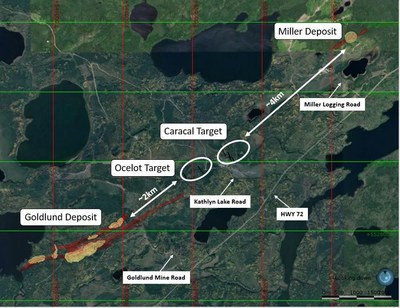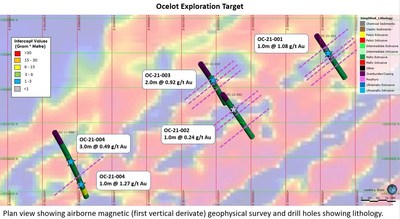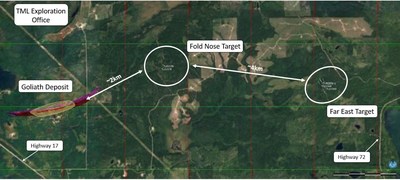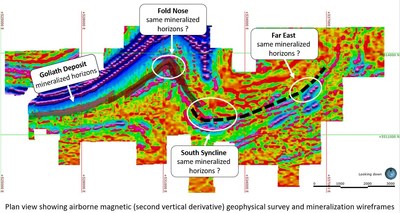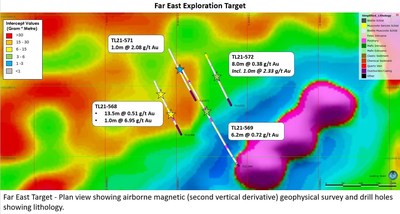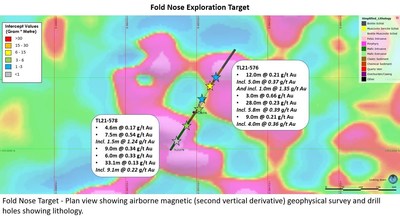TSX: TML OTCQX: TSRMF
New gold discovery at Ocelot target, as well as positive gold results from Fold Nose and Far East.
Highlights:
- Far East hole TL21-568 with 6.95 g/t Au over 1.0 metre from 86.0 to 87.0 metres downhole and 0.51 g/t Au over 13.5 metres from 172.5 to 186.0 metres downhole.
- Fold Nose hole TL21-578 with 0.54 g/t Au over 7.5 metres including 1.24 g/t Au over 1.5 metres from 170.0 to 177.5 metres downhole.
- Fold Nose hole TL21-576 with 0.23 g/t Au over 28.0 metres from 100.0 to 128.0 metres downhole.
- Ocelot hole OC-21-003 with 0.92 g/t Au over 2.0 metres from 79.0 to 81.0 metres downhole on a new target identified by Treasury Metals Geology team.
TORONTO, Feb. 17, 2022 /CNW/ - Treasury Metals Inc. (TSX: TML) (OTCQX: TSRMF) (“Treasury” or the “Company”) is pleased to announce results on three exploration targets tested during the 2021 drill campaign. Gold was discovered at the Ocelot target for the first time, and positive gold results were encountered in new drillholes at the previously identified Far East and Fold Nose mineralizations. These successes are part of Treasury’s 2021/2022 discovery program, supporting the development of the Goliath, Goldlund and Miller resources, and confirm our belief that Treasury’s land position will continue to deliver new discoveries.
The targets have assays pending, and all three are open at depth. The Ocelot discovery is one of a series of geophysical anomalies on the Goldlund structural trend northeast of the Goldlund deposit, undrilled prior to the 2021 campaign.
Jeremy Wyeth, President and CEO of Treasury Metals, commented: “I am very pleased to see positive results coming back on all of these three exploration targets. In 2021, we re-established a discovery drilling program focusing on identifying new targets for the first time since 2012 on Goliath and 2018 on Goldlund. Today’s discovery at Ocelot, with a number of new targets being drilled in early 2022, coupled with more gold results from Fold Nose and Far East, show the first-class exploration potential on Treasury’s large land position, close to the planned processing facilities, which will be described in the Pre- Feasibility Study slated for later in the year.”
Ocelot
During the 2021 drill campaign, the Company tested two Wild Cat targets on the Goldlund structural trend northeast of the Goldlund deposit. These targets were based on a series of geophysical anomalies with similar footprints to the Goldlund and Miller Deposits and sit located between the two deposits (Figure 1). Results released today are from four holes (897 metres) testing the Ocelot target over a strike length of 800 metres. From the logging and assay results, the Company believes this area hosts geology and mineralization similar to Zone 4 at Goldlund where a network of porphyry dykes creates a competency contrast allowing mineralizing fluids to penetrate in and adjacent to these dykes (Figure 2). Initial results are promising, showing mineralizing fluids two kilometres away from the Goldlund Deposit. Additional work is needed to determine the potential for more significant width or grade of mineralization. Results are pending on the second target, Caracal, but logging for that target showed geology more similar to Zone 1, Zone 7 and Zone 2/3 at Goldlund.
Far East
Located approximately 8km to East of the Goliath Deposit, the Far East target was based on geophysical trends that were first identified in 2011. The Company completed a four-hole test program on the target in 2012, with the last hole intersecting Goliath-style host rock, alteration and mineralization. With a renewed focus on growth through exploration the Company completed a six-hole (1,998 metres) initial program to test the continuity and get a better understanding of the geology in the area. The mineralization was found within felsic to intermediate volcanic rocks and associated with disseminated pyrite and trace sphalerite, both of which are characteristic of the Goliath deposit. Elevated results also correspond near and along the boundary of felsic porphyry intrusions. While not directly associated with Goliath mineralization, deformed porphyries are commonly identified in the hanging wall sediments above the deposit and could have played a role in fluid movement and the original emplacement of gold. Results are pending for the final two drillholes of the initial program. Once received, the program results will be analyzed and additional drillholes will be designed to further develop our understanding of this prospective target.
Highlights from the Far East include hole TL21-568, which intersected 1.0 metre grading 6.95 g/t Au and 13.5 metres grading 0.51 g/t Au (Figure 5). The porphyry dykes noted in logging of this Far East drill program may indicate that this mineralization is related to the hanging wall mineralization at Goliath and therefore the geology team will review the positions for follow up drilling to expand the potential for Goliath Main Zone type of mineralization to the northwest of these results.
Fold Nose
The Company completed a ten-hole (2,868 metre) drill program on the Fold Nose exploration area in 2021. This program was designed to aid in the geological understanding of the area. The geology team has been working to develop a geological model for the area and work is underway to constrain the controls on the higher-grade mineralization. The geology team sees that the host stratigraphy for the Goliath Deposit continues to the east and into the Fold Nose target area. The primary low-grade VMS stratigraphically-contained mineralization appears to be continuous from the Goliath Deposit to the east into the Fold Nose. The team has been able to model the fold geometry using structural measurements from surface mapping and host lithology marker horizons (Figure 4). Treasury is pleased to see the continuity of the primary low-grade VMS stratigraphically-contained mineralization, hole TL21-576 intercepted several wide lower-grade zones including 28.0 metres grading 0.23 g/t Au. Also, hole TL21-578 also intersected wide lower-grade zones including 7.5 metres grading 0.54 g/t Au and 33.1 metres grading 0.13 g/t Au.
The 2021 and 2022 drill campaigns are focused on unlocking the control of the higher-grade mineralization in the area. Our current theory for the control of the higher-grade mineralization is that it is related to stacked vein sets noted by geologists on surface and in core. Results from the 2021 drill program at the Fold Nose will help to increase the understanding of the controls on mineralization in this area. The company also plans to do detailed geological mapping in the Fold Nose to confirm the orientation of the quartz veins in the summer of 2022.
Table 1: New Significant Gold Intercepts from Recent Drilling
|
Far East |
||||||
|
Drill Hole |
Target |
From (m) |
To (m) |
Sample Length (m) |
Grade g/t Au |
|
|
TL21-568 |
Far East |
86.00 |
87.00 |
1.00 |
6.95 |
|
|
TL21-568 |
Far East |
172.50 |
186.00 |
13.50 |
0.51 |
|
|
TL21-569 |
Far East |
271.80 |
278.00 |
6.20 |
0.72 |
|
|
TL21-571 |
Far East |
158.00 |
159.00 |
1.00 |
2.08 |
|
|
TL21-572 |
Far East |
132.00 |
140.00 |
8.00 |
0.38 |
|
|
Including |
132.00 |
133.00 |
1.00 |
2.33 |
||
|
Fold Nose |
||||||
|
Drill Hole |
Target |
From (m) |
To (m) |
Sample Length (m) |
Grade g/t Au |
|
|
TL21-576 |
Fold Nose |
53.00 |
66.00 |
12.00 |
0.21 |
|
|
Including |
53.00 |
58.00 |
5.00 |
0.37 |
||
|
And including |
53.00 |
54.00 |
1.00 |
1.35 |
||
|
TL21-576 |
Fold Nose |
81.00 |
84.00 |
3.00 |
0.66 |
|
|
TL21-576 |
Fold Nose |
100.00 |
128.00 |
28.00 |
0.23 |
|
|
Including |
100.00 |
105.80 |
5.80 |
0.39 |
||
|
TL21-576 |
Fold Nose |
160.00 |
169.00 |
9.00 |
0.21 |
|
|
Including |
164.00 |
168.00 |
4.00 |
0.36 |
||
|
TL21-578 |
Fold Nose |
58.00 |
62.60 |
4.60 |
0.17 |
|
|
TL21-578 |
Fold Nose |
170.00 |
177.50 |
7.50 |
0.54 |
|
|
Including |
173.00 |
174.50 |
1.50 |
1.24 |
||
|
TL21-578 |
Fold Nose |
211.00 |
220.00 |
9.00 |
0.34 |
|
|
TL21-578 |
Fold Nose |
241.00 |
247.00 |
6.00 |
0.33 |
|
|
TL21-578 |
Fold Nose |
301.50 |
334.60 |
33.10 |
0.13 |
|
|
Including |
325.50 |
334.60 |
9.10 |
0.22 |
||
|
Ocelot |
||||||
|
Drill Hole |
Target |
From (m) |
To (m) |
Sample Length (m) |
Grade g/t Au |
|
|
OC-21-001 |
Ocelot |
71.00 |
72.00 |
1.00 |
1.08 |
|
|
OC-21-002 |
Ocelot |
57.00 |
58.00 |
1.00 |
0.24 |
|
|
OC-21-003 |
Ocelot |
79.00 |
81.00 |
2.00 |
0.92 |
|
|
OC-21-004 |
Ocelot |
137.00 |
140.00 |
3.00 |
0.49 |
|
|
OC-21-004 |
Ocelot |
219.00 |
220.00 |
1.00 |
1.27 |
|
|
Note: Reported intervals are drilled core lengths and do not indicate true widths. For duplicate samples, the original sample assays are used to calculate the intersection grade. All grades are un-capped. |
QA / QC
The Company has implemented a quality assurance and quality control (QA/QC) program to ensure sampling and analysis of all exploration work is conducted in accordance with the CIM Exploration Best Practices Guidelines. The drill core is sawn in half with one-half of the core sample dispatched to Activation Laboratories Ltd. facility located in Dryden, Ontario. The other half of the core is retained for future assay verification and/or metallurgical testing. Other QA/QC procedures include the insertion of blanks and Canadian Reference Standards for every tenth sample in the sample stream. A quarter core duplicate is assayed every 20th sample. The laboratory has its own QA/QC protocols running standards and blanks with duplicate samples in each batch stream. Additional checks are routinely run on anomalous values including gravimetric analysis and pulp metallic screen fire assays. Gold analysis is conducted by lead collection, fire assay with atomic absorption and/or gravimetric finish on a 50-gram sample. Check assays are conducted at a secondary ISO certified laboratory (in this case AGAT Laboratories located in Mississauga, Ontario) following the completion of a program.
Qualified Persons
Maura Kolb, M.Sc., P.Geo., Director of Exploration and Adam Larsen, P. Geo., Exploration Manager, are both considered as a “Qualified Person” for the purposes of National Instrument 43-101 Standards of Disclosure for Mineral Projects (“NI 43-101”), and have reviewed and approved the scientific and technical disclosure contained in this news release on behalf of Treasury.
About Treasury Metals Inc.
Treasury Metals Inc. is a gold focused company with assets in Canada. Treasury’s Goliath Gold Complex, which includes the Goliath, Goldlund and Miller deposits, is located in Northwestern Ontario. The deposits benefit substantially from excellent access to the Trans-Canada Highway, related power and rail infrastructure, and close proximity to several communities including Dryden, Ontario. The Company also owns several other projects throughout Canada, including the Lara Polymetallic Project, Weebigee-Sandy Lake Gold Project JV, and grassroots gold exploration property Gold Rock. Treasury Metals is committed to inclusive, informed and meaningful dialogue with regional communities and Indigenous Nations throughout the life of all our Projects and on all aspects, including: creating sustainable economic opportunities, providing safe workplaces, enhancing of social value, and promoting community well-being.
For information on the Goliath Gold Complex, please refer to the preliminary economic assessment, prepared in accordance with NI43–101, entitled “NI 43–101 Technical Report & Preliminary Economic Assessment of the Goliath Gold Complex: and dated March 10, 2021 with an effective date of January 28, 2021, led by independent consultants Ausenco Engineering Canada Inc. The technical report is available on SEDAR atwww.sedar.com, on the OTCQX at www.otcmarkets.com and on the Company website at www.treasurymetals.com.
To view further details about Treasury, please visit the Company’s website at www.treasurymetals.com.
Neither the TSX nor its Regulation Services Provider (as that term is defined in the policies of the TSX) accepts responsibility for the adequacy or accuracy of this release.
Forward-Looking Statements
This release includes certain statements that may be deemed to be “forward-looking statements”. All statements in this release, other than statements of historical facts, that address events or developments that management of the Company expect, are forward-looking statements. Forward-looking statements are frequently, but not always, identified by words such as “expects”, “anticipates”, “believes”, “plans”, “projects”, “intends”, “estimates”, “envisages”, “potential”, “possible”, “strategy”, “goals”, “objectives”, or variations thereof or stating that certain actions, events or results “may”, “could”, “would”, “might” or “will” be taken, occur or be achieved, or the negative of any of these terms and similar expressions. Actual results or developments may differ materially from those in forward-looking statements. Treasury disclaims any intention or obligation to update or revise any forward-looking statements, whether as a result of new information, future events or otherwise, save and except as may be required by applicable securities laws.
Since forward-looking information address future events and conditions, by their very nature they involve inherent risks and uncertainties. Actual results could differ materially from those currently anticipated due to a number of factors and risks. These include, but are not limited to, exploration and production for precious metals; delays or changes in plans with respect to exploration or development projects or capital expenditures; the uncertainty of resource estimates; health, safety and environmental risks; worldwide demand for gold and base metals; gold price and other commodity price and exchange rate fluctuations; environmental risks; competition; incorrect assessment of the value of acquisitions; ability to access sufficient capital from internal and external sources; and changes in legislation, including but not limited to tax laws, royalties and environmental regulations.
Actual results, performance or achievement could differ materially from those expressed in, or implied by, the forward-looking information and, accordingly, no assurance can be given that any of the events anticipated by the forward-looking information will transpire or occur, or if any of them do so, what benefits may be derived therefrom and accordingly, readers are cautioned not to place undue reliance on the forward-looking information.
Note to United States Investors
All resource estimates included in this press release have been prepared in accordance with Canadian standards, which differ in some respects from United States standards. In particular, and without limiting the generality of the foregoing, the terms “inferred mineral resources,” “indicated mineral resources,” “measured mineral resources” and “mineral resources” that may be used or referenced are Canadian mining terms as defined in accordance with National Instrument 43 101 – Standards of Disclosure for Mineral Projects under the guidelines set out in the Canadian Institute of Mining, Metallurgy and Petroleum (the “CIM”) Standards on Mineral Resources and Mineral Reserves (the “CIM Standards”). The CIM Standards differ significantly from standards in the United States. While the terms “mineral resource,” “measured mineral resources,” “indicated mineral resources,” and “inferred mineral resources” are recognized and required by Canadian regulations, they are not defined terms under standards in the United States. “Inferred mineral resources” have a great amount of uncertainty as to their existence, and great uncertainty as to their economic and legal feasibility. It cannot be assumed that all or any part of an inferred mineral resource will ever be upgraded to a higher category. Under Canadian securities laws, estimates of inferred mineral resources may not form the basis of feasibility or other economic studies. Readers are cautioned not to assume that all or any part of measured or indicated mineral resources will ever be converted into reserves. Readers are also cautioned not to assume that all or any part of an inferred mineral resource exists or is economically or legally mineable. Disclosure of “contained ounces” in a resource is permitted disclosure under Canadian regulations; however, United States companies are only permitted to report mineralization that does not constitute “reserves” by standards in the United States as in place tonnage and grade without reference to unit measures. Accordingly, information regarding resources contained or referenced in this [name of disclosure document] containing descriptions of our mineral deposits may not be comparable to similar information made public by United States companies.
SOURCE Treasury Metals Inc.

Contact
Jeremy Wyeth, President & CEO, T: +1 416 214 4654; Orin Baranowsky, CFO, T: +1 416 214 4654, Email: info@treasurymetals.com; Twitter @TreasuryMetals

